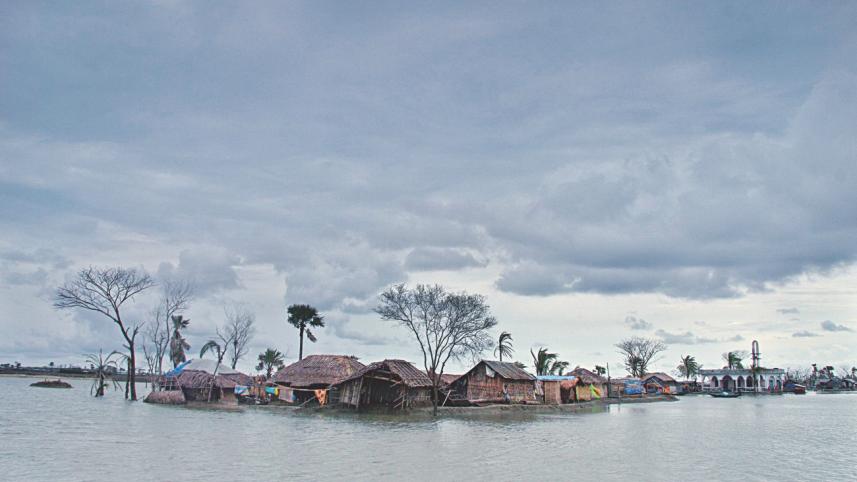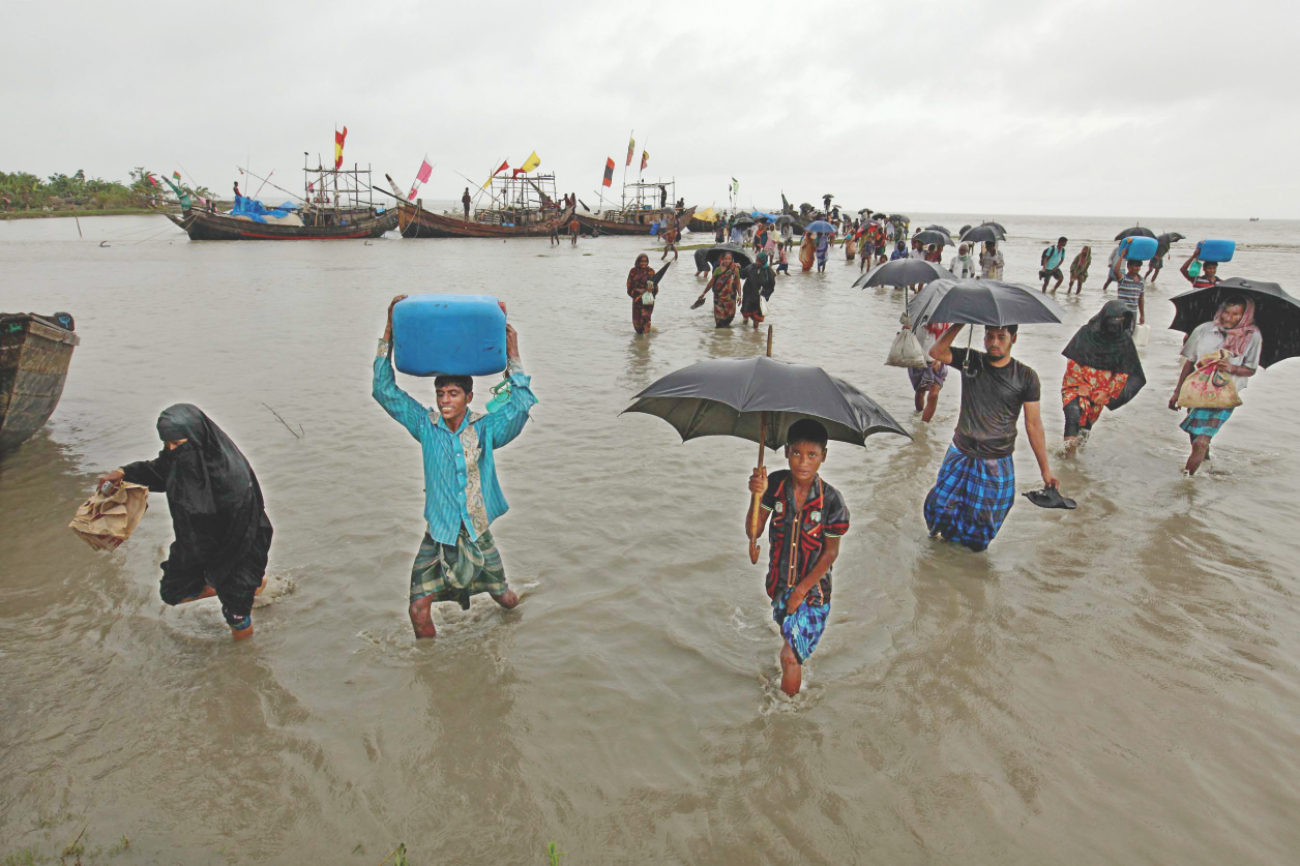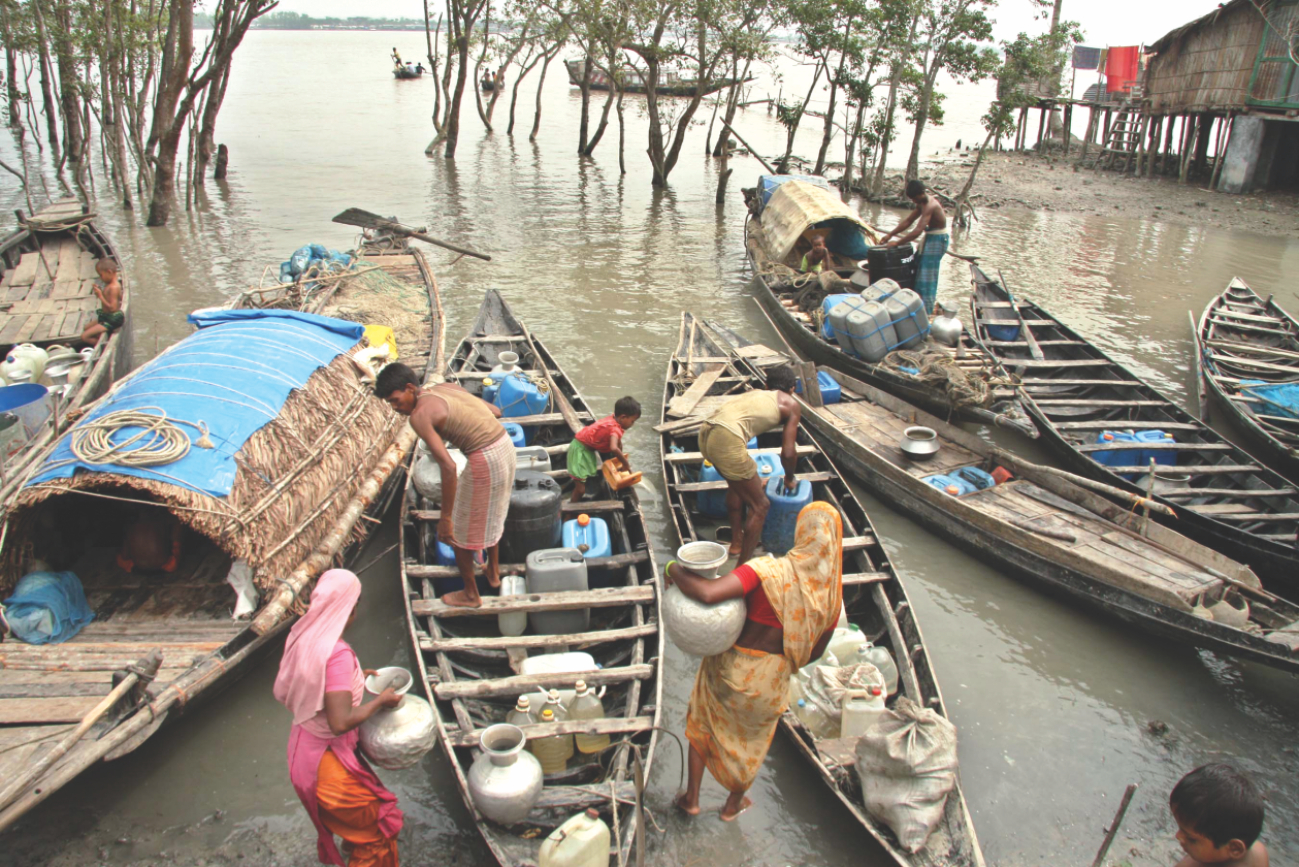Living on the Edge

A little egret sat gracefully on the floating platform of Jhulanta Para. It was calm and quiet, lazily using its beak to comfort its broken wing. Not scared of the human presence surrounding it, the bird looked directly at my camera while I snapped its pictures. Harun Miah, a honey collector and saviour of the egret, has adopted it as a part of his family as he says, "I found Hiron (the Egret's name given by Harun) in the forest. The bird was struggling to fly with its broken wing." He thought it would be wise to bring Hiron to his home as he says, "Bonbibi (the forest deity) saves my life everyday in the forest. So I thought I should save this small living being. Two homeless creatures can easily become friends," he says with a big smile.
Harun lost his home in 2009, when the cyclone Aila hit the costal belt of the country. His four acres of cultivable land and home near Nalian Bazar of Dacope, Khulna, was washed away by the Shibsha River. After that they could not find a small piece of land to erect their home again. His family and a large number of people from different parts of Dacope chose a 10 km long wrecked dam to build their homes again. The helpless Harun had no other option but to change his profession from a farmer to a honey collector.
Honey gathering may sound like a normal job but it is one of the riskiest jobs in the world. Honey gatherers risk getting mangled or killed by their deadly foe – the Royal Bengal tiger. For a farmer like Harun this new profession is not easy to grapple with. Climate change has changed his life and thousands like him, forever. It is a life that is precariously dependent on the moods of nature. Their so-called homes can, at any time, be washed away with a single tidal surge. In the jungle they meet deadly beasts and in water, the crocodiles. "Before cyclone Aila hit us, I never imagined of living such a risky life. But now, this is my reality," he says.
The swelling of sea surface temperatures in the Bay of Bengal and the Indian Ocean is one of the reasons behind repeated natural disasters like cyclones and tidal surges. The country's geographical location has put it in an inescapable situation. After Aila hit the costal belt, there was a major increase in climate induced migration from affected areas. An International Organization for Migration's (IOM) estimate claims that about 100,000 people, primarily men looking for work, migrated from four Upazilas alone -- Koyra, Paikgacha, Dacope and Batiaghata.

Jhulonto Para, now home to at least 10,000 displaced people, literally means a floating village. For the people living in this strip of land, they may not know the current usage of the term 'climate-induced migration' but they are very much part of it. All they know is that they have lost their ancestral home, land and livelihood. "We came to know about different government endeavours, which would rehabilitate us, several times. But we've not been fortunate enough to reap the benefits of any of these endeavours," Harun says.
Here houses are built on 'hanging' platforms made of bamboo that stand three-metres from the ground. They built the village against the soaring currents of Shibsha. "It was difficult but we made it," says Alauddin Mia, a boatman of Jhulonto Para. "Every month we change bamboos to make the houses stronger and to survive the tidal surges."
They have even invented their own method of building houses to endure tidal surges. With the help of empty barrels, a few of the bamboo houses have been made to float. People collect water and preserve it using their own indigenous methods.
Collecting water is a woman's job here. They have to run their own boat, the only communication system remain in Jhulantapara, against the deadly current of Shibsha. Nilu Bala travels long distances on boat to collect fresh water every day. "Running a boat is not an easy work. My hands have turned into steel," she says showing her palms hardened by arduous rowing. Women from different villages come to Nolian to collect fresh water. It turns into a long queue of women waiting for a single drop of water.
On one side, there is a large pond filled with saline water, while on the other is cultivable land -- the largest mangrove forest, the Sundarbans, separated by Shibsha. Google map shows the small strip of houses in Kolabogi, the lower part of Dacope Upazila, Khulna. It is now home to at least 1,000 displaced families.
Children have to walk at least three kilometres to go to the only private school, Pandit Chandra. Unfortunately, the school remains outside the range of the embankment that was made to protect the villagers in Kolabogi. The headmaster of the school, Supado Ray, says, "There are 453 students who are currently enrolled in the school. It is unfortunate that we are not able to provide our children with safety."
Inhabitants of the area have to rely on boats whenever they seek medical services. They have to travel at least 15km on boat to reach the Dacope Upazila Health complex. "Many pregnant women died in the last few years in the middle of the road. It is risky and we know it. But there is no other option," says Supado Ray.

Mojid Mia, a farmer says, "I have witnessed the massive flood of the late eighties and many similar catastrophes since then. Twenty years have passed and we still live on the brink of similar catastrophes. Every government comes to us with relief but none of them make a permanent settlement of the embankments."
The way climate change is posing a threat on the coastal belt of the country, and in the near future, scientists believe, Bangladesh might lose 17 percent of its land due to floods. This might create 20 million climate induced migrants from the costal and other parts of the country.
Khulna and Satkhira are the regions that have been hit hardest by cyclone Aila. Tidal waves, as high as 13 feet, damaged over 1,700 km long dams in Dacope and Koyra upazilas in 2009, as reported by the Water Development Board (WDB). According to figures by the WDB, faulty dams and saline water displaced over 200,000 people in the area over the last five years.
Atul Roy, a farmer from Kolabogi lost at least 200 bighas of land in river erosion. Two of his six sons moved to India with their families because they couldn't earn enough to feed their families or even provide them with shelter. A distressed Atul says that they are passing the most critical time of their lives.
With more than 230 waterways, Bangladesh is considered as one of the most disaster prone nations in the world. Most of the people living in the coastal areas believe that migration can help to reduce the risk to their lives.
Atul and his four other sons, who stayed behind with their families, do not want to migrate to India. They want to observe the whole situation for some more months. If the existing situation persists, they will have no choice but to resettle to another place in the country.
The decision to move from one place to the other is extremely difficult. Available resources, socio-economic and local political factors also play a crucial role. For that reason, M Inamul Haque, Chairman of the Institute of Water and Environment, believes that many factors, including the environment, drive people to migrate from the country, "Migration is only one among many possible responses to environmental change," he says.
The people living there have turned the tide to convert it into a story of hope and survival, rather than one of disaster. They have survived the hardest blow without any support from public and private organisations. They have even invented their own method of building houses to endure tidal surges. With the help of empty barrels, few of the bamboo houses can be made to float. People collect water and preserve it using their own indigenous methods.
"We are fighting against nature with bare hands," says Atul Roy. "I don't think our voice reaches the government, which is why we are trying to survive using our own means."
Climate change has isolated the whole community from the purview of government support and services. It's as if these people have organised their own independent community; a community of climate induced migrations. But the forces of nature will continue to lash out challenges on them that they may or may not be able to take on.
The writer is a journalist at The Daily Star.

 For all latest news, follow The Daily Star's Google News channel.
For all latest news, follow The Daily Star's Google News channel.